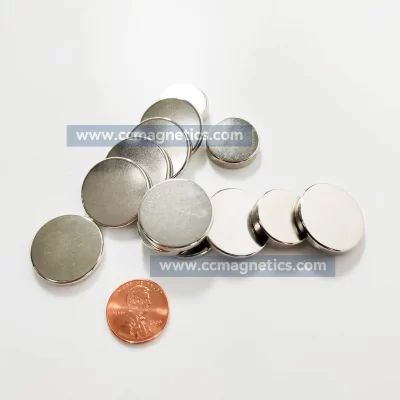Temu all of powerful Neodymium disc magnets (Quick Links)


| NO. | Dia×Thk (in) |
Dia×Thk (mm) |
Order Link |
| 1 | 0.08in×0.04in | 2mm×1mm | Order Now |
| 2 | 0.12in×0.04in | 3mm×1mm | Order Now |
| 3 | 0.12in×0.08in | 3mm×2mm | Order Now |
| 4 | 0.12in×0.15in | 3mm×4mm | Order Now |
| 5 | 0.12in×0.2in | 3mm×5mm | Order Now |
| 6 | 0.16in×0.04in | 4mm×1mm | Order Now |
| 7 | 0.16in×0.06in | 4mm×1.5mm | Order Now |
| 8 | 0.16in×0.08in | 4mm×2mm | Order Now |
| 9 | 0.16in×0.12in | 4mm×3mm | Order Now |
| 10 | 0.16in×0.16in | 4mm×4mm | Order Now |
| 11 | 0.16in×0.32in | 4mm×8mm | Order Now |
| 12 | 0.16in×0.39in | 4mm×10mm | Order Now |
| 13 | 0.19in×0.04in | 5mm×1mm | Order Now |
| 14 | 0.19in×0.08in | 5mm×2mm | Order Now |
| 15 | 0.19in×0.1in | 5mm×2.5mm | Order Now |
| 16 | 0.19in×0.12in | 5mm×3mm | Order Now |
| 17 | 0.19in×0.19in | 5mm×5mm | Order Now |
| 18 | 0.19in×0.32in | 5mm×8mm | Order Now |
| 19 | 0.23in×0.1in | 5.8mm×2.5mm | Order Now |
| 20 | 0.23in×0.06in | 6mm×1.6mm | Order Now |
| 21 | 0.236in×0.08in | 6mm×2mm | Order Now |
| 22 | 0.236in×0.12in | 6mm×3mm | Order Now |
| 23 | 0.236in×0.236in | 6mm×6mm | Order Now |
| 24 | 0.236in×0.39in | 6mm×10mm | Order Now |
| 25 | 0.28in×0.08in | 7mm×2mm | Order Now |
| 26 | 0.28in×0.2in | 7mm×5mm | Order Now |
| 27 | 0.31in×0.1in | 7.8mm×2.5mm | Order Now |
| 28 | 0.32in×0.04in | 8mm×1mm | Order Now |
| 29 | 0.32in×0.08in | 8mm×2mm | Order Now |
| 30 | 0.32in×0.12in | 8mm×3mm | Order Now |
| 31 | 0.32in×0.2in | 8mm×5mm | Order Now |
| 32 | 0.32in×0.32in | 8mm×8mm | Order Now |
| 33 | 0.32in×0.39in | 8mm×10mm | Order Now |
| 34 | 0.36in×0.04in | 9mm×1mm | Order Now |
| 35 | 0.36in×0.08in | 9mm×2mm | Order Now |
| 36 | 0.39in×0.04in | 10mm×1mm | Order Now |
| 37 | 0.39in×0.06in | 10mm×1.5mm | Order Now |
| 38 | 0.39in×0.08in | 10mm×2mm | Order Now |
| 39 | 0.39in×0.1in | 10mm×2.5mm | Order Now |
| 40 | 0.39in×0.12in | 10mm×3mm | Order Now |
| 41 | 0.39in×0.2in | 10mm×5mm | Order Now |
| 42 | 0.39in×0.32in | 10mm×8mm | Order Now |
| 43 | 0.39in×0.39in | 10mm×10mm | Order Now |
| 44 | 0.39in×0.79in | 10mm×20mm | Order Now |
| 45 | 0.47in×0.08in | 12mm×2mm | Order Now |
| 46 | 0.47in×0.1in | 12mm×2.5mm | Order Now |
| 47 | 0.47in×0.12in | 12mm×3mm | Order Now |
| 48 | 0.47in×0.19in | 12mm×5mm | Order Now |
| 49 | 0.47in×0.39in | 12mm×10mm | Order Now |
| 50 | 0.59in×0.04in | 15mm×1mm | Order Now |
| 51 | 0.59in×0.08in | 15mm×2mm | Order Now |
| 52 | 0.59in×0.12in | 15mm×3mm | Order Now |
| 53 | 0.59in×0.16in | 15mm×4mm | Order Now |
| 54 | 0.59in×0.39in | 15mm×10mm | Order Now |
| 55 | 0.63in×0.32in | 16mm×8mm | Order Now |
| 56 | 0.7in×0.08in | 18mm×2mm | Order Now |
| 57 | 0.7in×0.12in | 18mm×3mm | Order Now |
| 58 | 0.79in×0.08in | 20mm×2mm | Order Now |
| 59 | 0.79in×0.12in | 20mm×3mm | Order Now |
| 60 | 0.79in×0.16in | 20mm×4mm | Order Now |
| 61 | 0.79in×0.2in | 20mm×5mm | Order Now |
| 62 | 0.79in×0.24in | 20mm×6mm | Order Now |
| 63 | 0.79in×0.32in | 20mm×8mm | Order Now |
| 64 | 0.79in×0.39in | 20mm×10mm | Order Now |
| 65 | 0.79in×0.59in | 20mm×15mm | Order Now |
| 66 | 0.79in×0.79in | 20mm×20mm | Order Now |
| 67 | 0.98in×0.08in | 25mm×2mm | Order Now |
| 68 | 0.98in×0.12in | 25mm×3mm | Order Now |
| 69 | 0.98in×0.2in | 25mm×5mm | Order Now |
| 70 | 0.98in×0.39in | 25mm×10mm | Order Now |
| 71 | 1.18in×0.08in | 30mm×2mm | Order Now |
| 72 | 1.18in×0.12in | 30mm×3mm | Order Now |
| 73 | 1.26in×0.08in | 32mm×2mm | Order Now |
| 74 | 1.26in×0.12in | 32mm×3mm | Order Now |
| 75 | 1.26in×0.16in | 32mm×4mm | Order Now |
| 76 | 1.57in×0.19in | 40mm×5mm | Order Now |
| 77 | 1.57in×0.79in | 40mm×20mm | Order Now |
| 78 | 1.97in×1.18in | 50mm×30mm | Order Now |
Do NdFeB powerful magnets conduct electricity?
Conductivity is the ability of a substance to allow electrical current to pass through it. This ability mainly depends on the number and mobility of free electrons in the substance; NdFeB magnet is a metal alloy that has certain conductivity due to the characteristics of the metal itself. However, the electrical conductivity of NdFeB magnets is not outstanding compared to common conductors such as copper and aluminum. This is because although neodymium, iron, and boron are all metallic elements, they don't have many free electrons, so they are weak conductors.
In practical applications, we usually do not take advantage of this feature. On the contrary, what we pay more attention to is the magnetic properties of NdFeB magnets. This kind of strong magnetic material is mainly used to make motors, generators, hard drives, MRI scanning equipment, etc. The working principle of this equipment mainly uses electric current to generate magnetic fields, rather than using the conductivity of the magnet itself. When we design and build these devices, we use specialized conductors (such as copper and aluminum) to conduct electrical current and use the strong magnetic fields generated by neodymium iron boron magnets to convert or control the electricity.
NdFeB magnets are not very conductive, but in some cases, this property can be a problem. For example, if a magnet comes into direct contact with a conductive material, it may cause a short circuit or current leakage. Therefore, when using NdFeB magnets, we need to take some measures, such as wrapping them with insulating materials, to avoid this situation.
Do NdFeB magnets emit radiation?
In physics, radiation usually refers to energy propagating through space, such as electromagnetic waves (including X-rays, gamma rays, etc.) and particle rays (such as alpha particles, beta particles, etc.). These types of radiation are penetrating and, under certain conditions, may have effects on human health. However, the magnetic field produced by a magnet does not fall into this category of radiation. Magnetic fields themselves carry no energy and do not travel like radiation. Therefore, strictly speaking, magnets do not produce radiation that is harmful to the human body. In fact, many items in our lives, such as televisions, computers, mobile phones, etc., produce magnetic fields, but the intensity of these magnetic fields is far below the level that affects the human body.
For NdFeB magnets, due to their strong magnetism, the range and intensity of their magnetic field may exceed that of other types of magnets. When using NdFeB magnets, avoid placing the magnets close to electronic devices that may be affected by the magnetic field, such as pacemakers, televisions, computers, etc.
How long does it take for a powerful magnet to demagnetize?
A strong magnet is a special kind of magnet that has a strong magnetic field and attractive force. However, like any kind of magnet, strong magnets will gradually lose their magnetism under certain conditions, a process called demagnetization. How quickly a powerful magnet demagnetizes depends on several factors, including the magnet's material, temperature, external magnetic fields, and how the magnet is used.
1. The material of a powerful magnet plays an important role in its demagnetization speed. Generally speaking, permanent magnets have relatively stable magnetism, so the demagnetization speed is slow. However, if a strong magnet uses a soft magnetic material, such as ferrite, then it will be easier to demagnetize.
2. Temperature is also an important factor affecting the demagnetization speed of powerful magnets. When the magnet is in a high-temperature environment, heat will increase the thermal activation effect of the magnetic material, thereby destroying the orderly arrangement of the magnetic moments, causing the magnet to gradually demagnetize.
3. The external magnetic field also affects the demagnetization speed of powerful magnets. If there is a magnetic field stronger than the magnet in the surrounding environment, it will interfere with the orderly arrangement of the magnet's magnetic moments, thereby accelerating the demagnetization process.
4. The use of powerful magnets will also affect the degaussing speed. If a magnet is frequently subjected to stress such as shock, vibration or bending, its magnetism will gradually lose, eventually leading to demagnetization.
How to slow down the degaussing speed?
Keep the surface of the magnet clean and smooth to prevent dust and other particles from entering the magnet surface and causing damage.
Try to avoid excessive impact and stress on the magnet, which may cause the magnet to lose its magnetism.
Control the operating temperature of the magnet to avoid exposing the magnet to high-temperature environments, which can effectively delay the degaussing process.

 Deutsch
Deutsch Русский
Русский Español
Español Français
Français 한국어
한국어 日本語
日本語